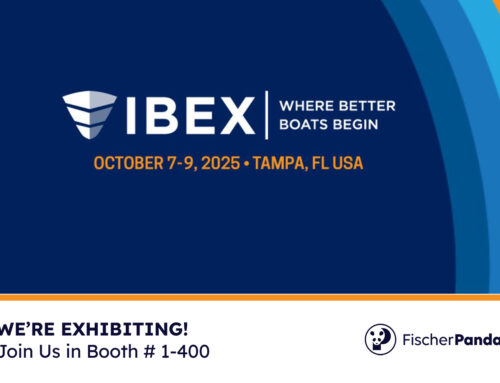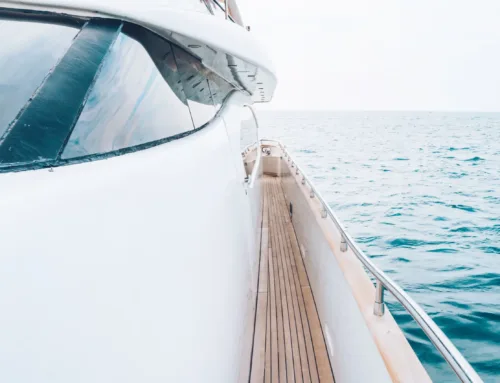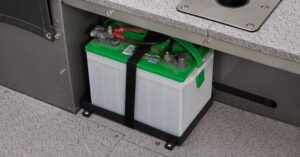 Utilized for power portability and the freedom it offers, energy storage devices in the form of batteries have been relied on for many years. 12-volt lead-acid and/or flooded batteries are used around the globe in many different industries and applications. In automobiles, for example, engines used stored energy in an on-board battery to power the starter, and ignite the engine. Once running, engines will rely on an alternator to generate the needed electricity, and charge back the battery. Advanced marine generators from Fischer Panda rely on the same process and energy storage devices, in the form of a designated starter battery. This battery will store and supply on demand the energy needed to engage the starter and get the generator engine running. Additionally, it will continue to supply energy to the generator’s electrical controls as needed.
Utilized for power portability and the freedom it offers, energy storage devices in the form of batteries have been relied on for many years. 12-volt lead-acid and/or flooded batteries are used around the globe in many different industries and applications. In automobiles, for example, engines used stored energy in an on-board battery to power the starter, and ignite the engine. Once running, engines will rely on an alternator to generate the needed electricity, and charge back the battery. Advanced marine generators from Fischer Panda rely on the same process and energy storage devices, in the form of a designated starter battery. This battery will store and supply on demand the energy needed to engage the starter and get the generator engine running. Additionally, it will continue to supply energy to the generator’s electrical controls as needed.
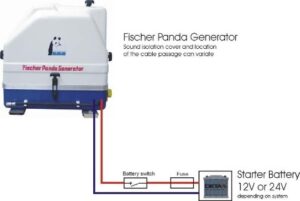 In order for a battery to provide the energy needed to start a marine generator, it needs to have the required capacity. If you are unfamiliar with the relationship between a battery’s voltage and capacity, seeing a battery readout of around 12-12.5 VDC may suggest to you the battery is in good health, and your generator is the one with a mechanical issue. Before you focus your efforts on the mechanical functionality of your marine generator, you need to check the battery’s capacity. There are two ways to do this: Load testing with resistive test instruments, or by watching for voltage drops during a load cycle.
In order for a battery to provide the energy needed to start a marine generator, it needs to have the required capacity. If you are unfamiliar with the relationship between a battery’s voltage and capacity, seeing a battery readout of around 12-12.5 VDC may suggest to you the battery is in good health, and your generator is the one with a mechanical issue. Before you focus your efforts on the mechanical functionality of your marine generator, you need to check the battery’s capacity. There are two ways to do this: Load testing with resistive test instruments, or by watching for voltage drops during a load cycle.
To test the battery capacity with resistive instruments, first attach a battery load tester to the battery terminals. Activate the resistive load, and the instrument meter will tell you if the battery’s capacity is good or bad. The alternative method is to monitor the battery voltage readout on your control panel during a start cycle. If your battery’s voltage drops from 12 to 9 or 10, your battery does not have the required capacity. In order to restore your battery to its initial capacity, you will have to either charge the battery and add distilled water, or simply charge it for maintenance-free units. Any battery in functioning condition will charge up, and can be put back in use quickly. If your battery has one or more dead cells, however, it will no-longer be able to charge to a useful capacity, and will require replacement.
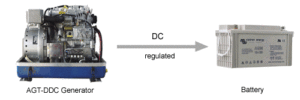 In an effort to preserve your battery’s capacity over time, Fischer Panda installs dynamo units into our marine generators, creating an electrical charge that is put through a voltage regulator that smooths out energy delivery and charges your battery. Additionally, you always have the option of using an external battery charger to perform this task. If you choose to use the external charger, you will want to unplug the wiring harness leading to and from the voltage regulator. If you fail to do this, the two charge sources will be at odds, and result in a damaged and nonoperational voltage regulator.
In an effort to preserve your battery’s capacity over time, Fischer Panda installs dynamo units into our marine generators, creating an electrical charge that is put through a voltage regulator that smooths out energy delivery and charges your battery. Additionally, you always have the option of using an external battery charger to perform this task. If you choose to use the external charger, you will want to unplug the wiring harness leading to and from the voltage regulator. If you fail to do this, the two charge sources will be at odds, and result in a damaged and nonoperational voltage regulator.
Fischer Panda is one of the leading marine generator manufacturers, offering some of the most advanced AC and DC units on the market. From efficiency, to noise-reduction, to battery capacity – we cut no corners when delivering on quality, value, and performance. Interesting in learning more? Give us a call today at (954) 462-2800, or request a free quote.




